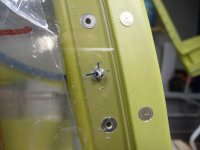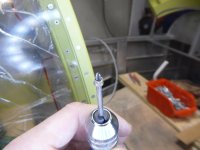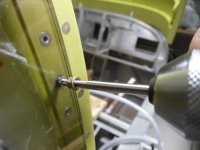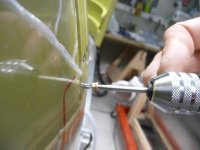I, too, am on window #2. The first one broke off a 2" chunk in one of the first holes we drilled into the roll bar. My friend was running the drill while I sat in the baggage area to back up the aft holes. We used a pointy-tipped #40 plexiglass drill bit in a battery-powered electric drill because it could turn slower than the air drill. (That was a mistake in my thinking. The speed that matters is the feed speed, not the drill bit rotation speed.) The off-center weight of the drill made it hard to line the bit up perfectly with the hole while drilling it as well as hard to control feed pressure. So the bit was slightly off center when it got to the pilot hole in the roll bar, fed into the pilot hole, and moved laterally faster than the flutes could cut the plexiglass to make room, knocking out the chunk of window #1.
That was a hard day, harder for my friend because he used to do this (airplane construction) for a living where people got fired for scrapping expensive parts and because this was his first real contribution to my "pile of shame" in the corner of the basement. For me, it wasn't so bad because now I have a plexiglass window next to trim tab #1 and a handful of other parts. As I have said before when people say to practice techniques on scrap material, my shop is equal opportunity: every part that comes in has a fair shot at becoming scrap material.
Anyhow, we got the new window, improved our technique,[1] and carried on. I read this thread beforehand and let out a huge sigh of relief when we finished the tapping per the plans. Thanks to those who went before on that front!
Then we removed the window and started drilling #27 the holes, thankfully starting with the aft center hole because the bit self-fed and caused a chip and a couple of small cracks.[2] I say 'thankfully' because whatever I do to solve the problem will be symmetrical, and that hole in the fuselage top skin is hard to reach to dimple anyhow. I used a step drill to slowly remove material until there is no damage remaining in the plexiglass, which ended up being 3/8". I have spent the past week debating how to fill that hole, which is just a matter of finding a piece of material I can use as a bushing and deciding whether to use a washer-head screw or the original flush-head screw, countersinking the bushing to fit.
I don't envy those who have had to remove broken taps from their roll bars, and I'm honestly shocked I didn't have to do that given my luck with things like that. I had a car where the rear license plate was held on by 3 bolts, because the previous owner lived in a salty climate and I broke an EZ-Out off in the bolt that held that corner of the license plate on. When I sold the car, it came with a half an EZ-Out because I never did figure out a solution. But the moral of the story is that there is more than one way to screw up your window, and we are all in this together.
[1] Our improved technique for match-drilling the window/roll bar holes was to put the pointy plexiglass #40 bit in a Dremel, which is lightweight and nearly symmetrical, so there is no force trying to turn you off-angle and you have more fine control of the feed pressure. Once we got through the plexiglass, the howl of the bit tip on the aluminum being an important clue, we switched to a non-pointy #40 bit in an air drill to go through the aluminum. Combined with slowing down the feed of the bit into the hole and better hole alignment thanks to the Dremel step, this drastically improved our results and we had zero problems.
[2] It worked much better to drill the holes up to #36 and then #27. The roll bar edge will have been drilled to #36 and then tapped #6-32, so you can go directly to #27 there and you're barely removing any material, just the threads you tapped into the plexi. But the holes that you match drilled #40 from the aft top skins will still be #40, so going one step at a time worked better for us.












